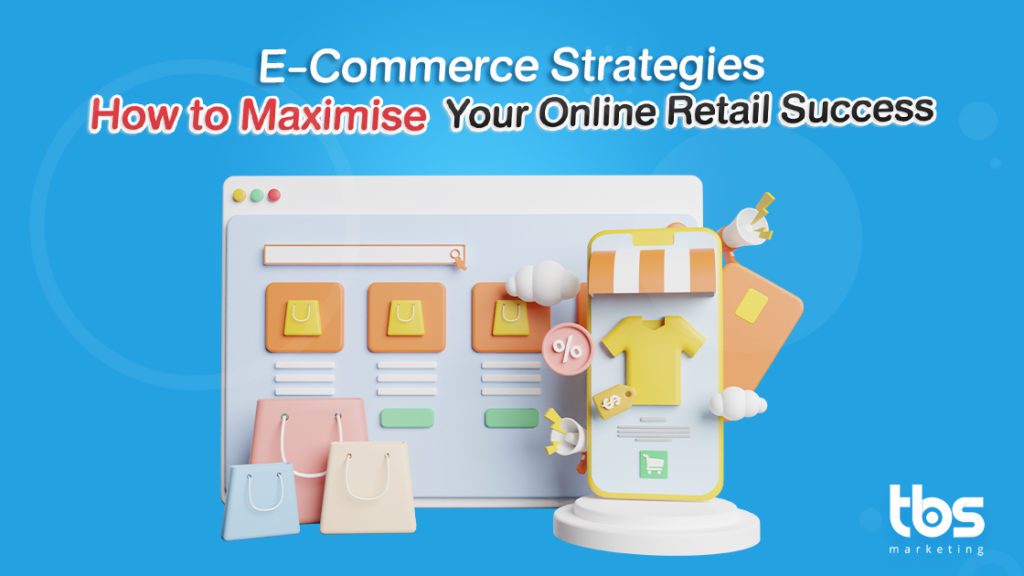
E-commerce, also known as electronic commerce, is the process of buying and selling goods or services over the internet
The COVID-19 pandemic has significantly impacted the business world, putting more importance on e-commerce businesses to adapt to changing consumer behaviour. Now, businesses can offer to sell products or services online 24/7, reaching a broader audience and provide a more personalised shopping experience.

According to recent statistics, e-commerce sales are anticipated to increase by 10.4% in 2023 with 20.8% of retail purchases projected to occur online. This growing trend in online shopping presents an opportunity for businesses to increase sales and revenue by establishing a strong online presence.
Whether you’re starting an e-commerce business or looking to improve your online retail success, this blog will cover a range of topics and best strategies for e-commerce. From building a robust brand and website to utilising social media and optimising search engines, this blog aims to help businesses maximise their e-commerce success.
What are some strategies for E-commerce?
1.Developing a Strong Brand and Unique Value Proposition
Your brand is what sets you apart from your competitors. Developing a strong brand identity and unique value proposition is crucial for attracting and retaining customers. Consider your target audience, brand values, and unique selling proposition (USP) when developing your brand strategy.
For example, Amazon’s UVP is centred around convenience and customer service. The company’s fast and reliable shipping options, easy returns, and customer reviews make it a go-to choice for online shoppers. This UVP has helped Amazon become the largest e-commerce retailer in the world. What’s your UVP?
2.Building a High-Performing E-Commerce Website
Your website is the foundation of your e-commerce business. It’s essential to have a website that is fast, user-friendly, and visually appealing. To optimise your website for success, focus on improving website speed, designing a user-friendly interface, and using long-tail keywords for better SEO.
By optimizing mobile speed, even with just a 0.1 second increase, approximately 9.1% more shoppers are likely to add items to their cart.

Optimize the user experience (UX) of your e-commerce website with this checklist.
- To improve website speed, consider reducing image sizes, minimising HTTP requests, and using a content delivery network (CDN).
- To design a user-friendly interface, focus on intuitive navigation, clear calls-to-action, and simple checkout processes.
- Lastly, use long-tail keywords, conduct keyword research and optimise your product pages and blog content accordingly.
3.Driving Traffic to Your E-Commerce Site through Search Engine Optimisation (SEO)
Search engine optimisation (SEO) is the process of optimising your website to rank higher in search engine results pages (SERPs). Optimising for search engines can help you attract more traffic to your e-commerce website, increase your visibility, and improve your credibility.
4.Enhancing Customer Experience and Loyalty through personalisation and Customer Service
Personalisation and excellent customer service can help improve customer satisfaction and loyalty. Personalise your customer experience by offering personalised product recommendations, sending personalised emails, and tailoring your website content to the individual.
5.Leveraging Social Media for E-Commerce Success
Social media is a powerful tool for e-commerce businesses. Use social media platforms to engage with customers, build brand awareness, and drive traffic to your website. Consider using social media ads to target specific audiences and promote your products.

6.Maximising Sales with Upselling and Cross-Selling Techniques
Upselling and cross-selling are effective techniques for increasing revenue. Upselling involves encouraging customers to purchase a more expensive product, while cross-selling involves suggesting related products that complement their purchase. Consider bundling products or offering discounts on related products.
7.Streamlining Operations and Improving Efficiency
Efficiency is essential for success in e-commerce. To achieve this, businesses should consider automating processes, reducing inventory costs, and optimising their supply chain.
By utilising e-commerce platforms such as Shopify, businesses can automate their supply chain,manage inventory,simplify payment processing,and enhance customer engagement through various marketing features.
Continue reading to discover more automated e-commerce platforms that may suit your needs.
Best Practices for Implementing E-Commerce Strategies
Implementing e-commerce strategies is not a one-time event. It requires continuous effort, and businesses need to remain agile and adaptable to changing market conditions.
Here are five best practices for implementing e-commerce strategies effectively:
1. Conducting Market Research and Competitor Analysis
To be successful in e-commerce, businesses need to understand their target market and the competition. Conducting market research and competitor analysis can provide valuable insights into consumer preferences, market trends, and gaps in the market. This information can help you develop effective marketing strategies and differentiate your brand from competitors.

Businesses can use various tools and methods for market research and competitor analysis. Some of these include:
- Surveys: Surveys can be used to gather information about customer preferences and opinions. Businesses can use online survey tools to collect data from a large sample size.
- Social media listening: By monitoring social media conversations, businesses can gain insights into customer opinions and preferences. This can help businesses understand their target audience and develop effective marketing strategies.
- Website analytics: Website analytics tools like Google Analytics can provide valuable information about customer behaviour and preferences. This information can be used to optimise website design and improve user experience.
- Competitor analysis tools: Businesses can use tools like SEMRush or Ahrefs to analyze their competitors’ websites and online presence. This can help businesses identify gaps in the market and develop strategies to differentiate themselves from competitors.
- Focus groups: Focus groups involve gathering a group of people to discuss a specific product or service. This can provide valuable insights into customer preferences and opinions.
2. Identifying and Understanding Your Target Audience
Understanding your target audience is essential for developing effective e-commerce strategies. Businesses need to know their customers’ preferences, pain points, and purchasing behaviour. This knowledge can help tailor your product offerings, messaging, and user experience to better appeal to your target audience.
For example, if you are selling skincare products, your customers’ pain points might include acne, dry skin, or wrinkles.

Identifying these pain points can help you tailor your messaging and product offerings to address these specific challenges. You can create marketing campaigns that speak directly to your customer’s pain points, highlighting how your products can solve their problems. This can help increase engagement and conversion rates.
3. Establishing Clear Goals and Metrics for Success
Setting clear goals and metrics is essential for measuring the success of your e-commerce strategies. Goals can be anything from increasing traffic to your website to increasing conversions, improving customer satisfaction, or increasing revenue. Establishing clear metrics and tracking progress towards these goals can help businesses make data-driven decisions and adjust their strategies as needed.
4. Investing in the Right E-Commerce Tools and Technology
Investing in the right e-commerce tools and technology can help streamline operations, improve efficiency, and provide valuable insights into your e-commerce performance. This can include e-commerce platforms, analytics tools, marketing automation tools, and customer service software.
Analytics tools like Google Analytics can help track website traffic, and user behaviour, and optimise campaigns. Marketing automation tools such as Mailchimp and HubSpot enable businesses to automate their marketing efforts and create targeted campaigns.
If your e-commerce business is struggling to find the appropriate tool, TBS Marketing can assist you in finding the right solution.
5. Continuously Measuring and Analyzing Your E-Commerce Performance
Continuously measuring and analyzing your e-commerce performance is crucial for identifying areas for improvement and making data-driven decisions. This can include monitoring website traffic, conversion rates, bounce rates, and customer satisfaction. Analyzing this data can provide valuable insights into what’s working and what’s not, allowing businesses to optimise their e-commerce strategies for maximum impact.
The emergence of new technologies

The e-commerce industry is being transformed by emerging technologies such as AI, blockchain, and voice assistants, which can improve personalisation, customer support, and automation. To successfully integrate these technologies, businesses must prioritize data-driven decision-making, focus on personalisation and customer experience, and prioritize security and privacy. Implementing website security and data protection measures can also increase the trustworthiness of e-commerce content.
Which E-commerce platform is best for your business?

E-commerce platforms such as Shopify, WooCommerce, and Magento offer a range of features to help businesses set up and manage their online stores.
Let’s delve to the pros and cons of each:
Pros – Easy to use, great for beginners, offers a range of features and customization options, good customer support, and integrates well with third-party apps.
Cons – Monthly subscription fees can add up, transaction fees are charged for using third-party payment gateways, and advanced features may require additional costs.
Pros – Free and open-source, highly customizable with a wide range of plugins and themes, can integrate with WordPress sites easily, and offers full control over the store and data.
- Cons – Requires technical knowledge for setup and customization, may need to purchase additional plugins for some features, and can become slow and unstable with a high number of products.
Pros – Highly scalable and customizable for larger businesses, offers a wide range of features and extensions and has a strong community for support.
Cons – Can be expensive and complicated to set up and maintain, requires technical knowledge, and may have slower page loading speeds.
Ultimately, the best platform for your business will depend on your specific needs, budget, and technical knowledge. It’s important to thoroughly research and compare different platforms before making a decision. If you need any further help, TBS marketing is at your assistance as we are familiar with all these platforms and readily guide your business in the right direction.
In conclusion, e-commerce strategies are crucial for success in today’s business world, and businesses that prioritize them can gain a significant competitive advantage.
By following these e-commerce strategies and best practices, businesses can improve their chances of online retail success and stay competitive in a rapidly evolving online marketplace.
